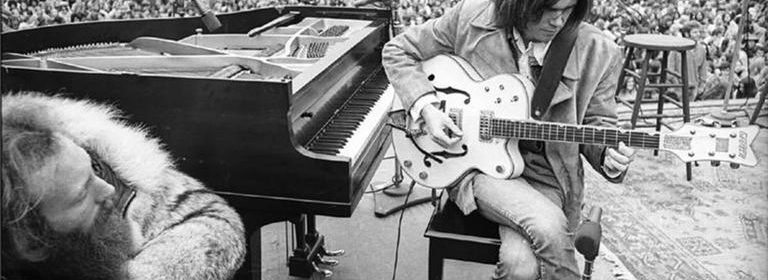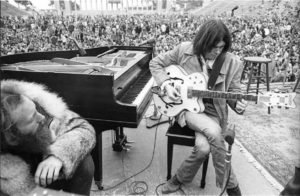
HENRY DILTZ
Henry Diltz will show photos of Neil Young and other artists at “Tribute to Laurel Canyon.”
Most of them brought their guitars. If you wrote songs in the late 1960s and early ’70s, you might have made your way to Laurel Canyon, the rustic Los Angeles neighborhood tucked into the Hollywood Hills.
Just minutes from the Sunset Strip, it was a world apart from the City of Angels, says Henry Diltz, who brought his camera instead. Using nothing more than “God’s light,” he says, Diltz created the all-natural look of the Laurel Canyon music scene, shooting classic album covers for central figures including Crosby, Stills and Nash and harmonious newcomers such as James Taylor.
For “Tribute to Laurel Canyon,” this year’s edition of Berklee College of Music’s ongoing Great American Songbook series, Diltz is bringing his slideshow — his intimate photos of Joni Mitchell, Linda Ronstadt, Carole King, Jackson Browne, the Eagles, and many more of the singer-songwriters who made the name Laurel Canyon synonymous with their psychoactive brand of folk-rock.
Strictly speaking, the Great American Songbook refers to the pop and jazz standards written during the first half of the 20th century by titans such as George Gershwin, Irving Berlin, and Duke Ellington. Berklee students and faculty have honored each of them in past years, but they’ve also celebrated the work of Bob Dylan and Stevie Wonder, as well as the music of Disney, Motown and Nashville, notes ensemble professor Ken Zambello.
“You can’t tell me that James Taylor isn’t as good a songwriter as someone like Irving Berlin,” says Zambello, musical director of the show, which takes place Sunday at the Berklee Performance Center. “Same with Carole King.”

HENRY DILTZ
Joni Mitchell
Diltz will be on hand to provide color commentary between songs, reminiscing about his hippie days in the canyon, where talented musicians converged from all over North America in the sprawling homes of “Mama” Cass Elliot, the den mother they considered the Gertrude Stein of folk-rock; Frank Zappa, who lived for a time in the grand log cabin that once belonged to cowboy actor Tom Mix; and the Monkees’ Peter Tork, whose hillside home had orange walls and huge picture windows.
“It was a time and place, an era that has almost become mythological, like Camelot,” says Diltz, whose enthusiasm for life has evidently not waned in the decades since.
The beauty of Laurel Canyon in its heyday, he says, was its best-of-both-worlds setting. It was undeniably part of the city, a short drive by Karmann Ghia or DayGlo Rolls Royce from the record labels, recording studios, and nightclubs such as the Troubadour, where the backing band that would become the Eagles first convened.
Yet “there were coyotes yipping at night, owls hooting,” says Diltz. “Up the hill, you were poised above the big city. You could see it gleaming down there. It was like you had an overview of life.”
The Berklee event will feature a medley of songs by the Mamas and the Papas, whose “California Dreamin’ ” captured the westward surge of a generation, as well as signature songs from Taylor, King, Ronstadt, Mitchell and more of Laurel Canyon’s key figures. The Doors, who came together around Venice Beach, will be acknowledged, as will Laurel Canyon visitors Jimi Hendrix (who stayed at Tork’s and Zappa’s houses) and Paul McCartney (whose photographer wife, Linda, was friendly with Diltz).
The styles varied, in some cases wildly. But Diltz tags it all as “wooden music” — authentic, heartfelt, primarily acoustic.
To mark the McCartney connection, the Berklee ensemble is set to perform the Beatles’ “Let It Be.”
“Our version is closer to Jennifer Hudson’s, with a gospel influence,” says Zambello, who is an official voter for the Rock and Roll Hall of Fame. “We try to take songs that fit the talent we have.”
Diltz has been to Berklee several times in recent years, having been invited to speak to classes and present his famous photographs. He thinks he might have more than a million images archived in his North Hollywood bungalow.
“I fancy myself an existentialist. I like to live in the moment. Yet here I am saving all these past moments. It’s a little weird,” he says with a laugh.
He was touring with his own group, the Modern Folk Quartet, when he first stumbled into photography, he says. (His bandmate Cyrus Faryar would go on to establish a quasi-commune in Burbank called the Farm, where the Lovin’ Spoonful’s John Sebastian lived for a time in a tie-dye tent.)
“I picked up a camera because I was a bit high, and we went into a secondhand shop,” he recalls. He didn’t realize he was shooting slide film: “I just looked through the hole and pushed the button. They all came out great, so I said, well, let’s get a slide projector. I saw my first picture hit the wall, 7 or 8 feet wide with all that color, and it was magic.”
As it turned out, his straightforward approach to photography was perfectly suited to the music his friends were making.
“Looking back, I think angels were involved somewhere in all this,” he says.




Grate article, thanks for that.
You can dance if you want to
Leave this world behind…